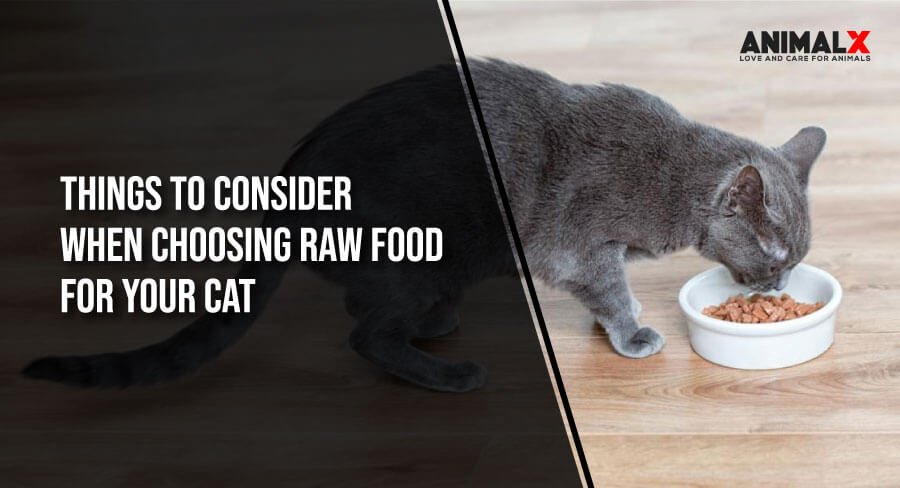Things to Consider When Choosing Raw Food for Your Cat
As a cat owner who wants to provide your feline friend with a diet that contributes to their overall health, you may have considered a raw food diet. Raw food diets for cats have gained popularity among pet owners in recent years, as they mimic the natural diet of wild cats.
As obligate carnivores, cats require a diet consisting primarily or exclusively of animal tissue to meet their nutritional needs. Cats have evolved as hunters, and their bodies have adapted to a diet rich in animal protein. So, raw food is often the ideal option for felines.
Whether you want to switch your kitten or adult cat to raw food, it’s essential to familiarize yourself with a few factors before the transition. Here are a few things to remember when choosing raw food for your furry friend.

Understand the Basics of a Raw Food Diet
A raw food diet for cats consists of uncooked, biologically appropriate ingredients. It typically includes raw meat, bones, and organs. This diet aims to replicate a cat’s natural diet in the wild, primarily consisting of prey. When you choose a reputable brand with expertise in creating raw pet food, you feed your furry friend raw recipes made without added processes.
Many believe that a raw food diet promotes better digestion, healthier skin and coats, improved dental health, and increased energy levels in cats. However, it is important to consult with a veterinarian to ensure that the diet meets the cat’s nutritional needs and to address any potential risks or concerns associated with feeding raw food.
Consult with a Veterinarian
Before transitioning your cat to a raw food diet, it is crucial to consult with a veterinarian. They can provide valuable insights into your cat’s nutritional requirements and guide you through the transition process. A veterinarian can also help address any potential health concerns or dietary restrictions your cat may have.
Read More: How Cold is Too Cold for A Bernese Mountain Dog?
Assess Your Cat’s Individual Needs
Consider your cat’s age, health condition, activity level, and any allergies or sensitivities they may have. Kittens, adult cats, and senior cats have different nutritional needs, so choosing a raw food diet that caters to their specific life stage is important.
You should also take into account their personal preferences and dietary habits. Some cats may prefer certain types of meat or have difficulty adjusting to new textures. By carefully evaluating your cat’s health, nutritional needs, and individual preferences, you can make an informed decision when selecting a raw diet that promotes their overall well-being and satisfies their unique taste buds.
Ensure a Balanced Diet
A suitable raw food diet should include a variety of protein sources, such as chicken, turkey, beef, and fish, and contain essential nutrients like taurine, omega-3 fatty acids, and vitamins and minerals. While raw meat forms the foundation of the diet, it should be supplemented with other components like bones for dental health and organs for vital nutrients.
Quality and Sourcing of Ingredients
The quality and sourcing of ingredients are paramount when selecting raw food for your cat. Look for reputable brands that use quality meats made without added processes. It’s essential to prioritize high-quality ingredients to minimize the risk of contamination or nutrient deficiencies.
When you buy raw cat food online, look for a brand that offers premium recipes formulated as nature intended. Choose a recipe with zero fruit or veggies to keep your pet healthy and thriving. Carefully choosing raw food will ensure you feed your cat a recipe that is unproblematic to their digestive systems. Check if the brand follows strict manufacturing and safety standards to ensure the food is free from contaminants and pathogens.
Another important factor is the variety of recipes when choosing raw cat food. Look for brands that provide a variety of protein sources to mimic a cat’s natural diet and offer a balanced nutritional profile. Consider your cat’s specific dietary needs, such as allergies or sensitivities, and opt for brands that provide specialized formulas to accommodate those requirements. Lastly, read reviews and seek recommendations from other cat owners or veterinarians to gain insights into the brand’s quality, palatability, and overall customer satisfaction.
Handling and Storage
Raw food must be handled and stored correctly to prevent bacterial growth and contamination. A brand that uses freeze tunnel technology is the ideal choice, as this technology freezes the patties quickly, helping to reduce bacteria growth. Follow the manufacturer’s instructions for storage, thawing, and serving raw food to ensure your cat’s safety.
Transitioning Gradually
Transitioning your cat to a raw diet should be done gradually to avoid digestive issues. Start by introducing small amounts of raw food mixed with their current diet, gradually increasing the proportion of raw food over time. This transition period allows their digestive system to adapt to the new diet.
Monitoring Health and Well-being
Once your cat has transitioned to a raw food diet, closely monitor their overall health, body weight, coat condition, energy levels, and litter box habits. Regular veterinary check-ups are essential to ensure your cat’s nutritional needs are met and address any concerns that may arise.
Risks and Precautions
While raw food diets have benefits, they also come with potential risks to cats and humans if not handled correctly. A reputable raw food brand will ensure safety when packaging and transporting its products. However, pet owners must handle raw food safely and maintain good hygiene when preparing their cat’s meals. Regularly disinfect food bowls, feeding utensils, and food preparation surfaces.
Choosing a raw food diet for your cat requires careful consideration and understanding of their needs. Although a raw pet diet may offer numerous health benefits, it is essential to consult a veterinarian, choose the right recipe, and properly handle and store the raw food. By considering these factors, you can make an informed decision that promotes your cat’s health and well-being. Remember, the key to a successful raw food diet is balance, quality ingredients, and responsible handling to ensure a healthy and happy feline companion.




